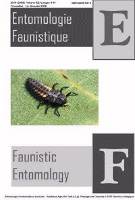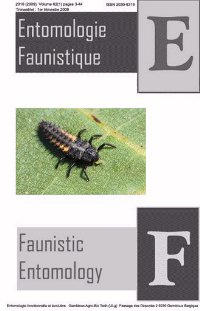- Accueil
- Volume 78 (2025)
- The first report of some Aphelinidae and Azotidae (Hymenoptera: Chalcidoidea) of Morocco
Visualisation(s): 190 (0 ULiège)
Téléchargement(s): 51 (0 ULiège)
The first report of some Aphelinidae and Azotidae (Hymenoptera: Chalcidoidea) of Morocco

Document(s) associé(s)
Version PDF originaleRésumé
Six espèces sont signalées pour la première fois au Maroc, venant s’ajouter à la faune des familles Aphelinidae et Azotidae (Hymenoptra: Chalcidoidea). Ces découvertes sont le fruit de recherches menées au sein de la forêt de chêne-liège de la Maâmora et de découvertes faites lors de visites aux musées. Il s’agit pour chaque famille des espèces suivantes : Aphelinus abdominalis (Dalman, 1820), Encarsia berlesei (Howard, 1906), E. lutea (Masi, 1909), E. mineoi Viggiani, 1982, Eretmocerus emiratus Zolnerowich & Rose, 1998 et Ablerus perspeciosus Girault, 1916.
Abstract
Six species are reported for the first time in Morocco, adding to the fauna of the families Aphelinidae and Azotidae (Hymenoptra: Chalcidoidea). (Hymenoptera: Chalcidoidea). These findings are the result of research conducted in the cork oak Maâmora forest and discoveries made during visits to museums. Each family includes the following species: Aphelinus abdominalis (Dalman, 1820), Encarsia berlesei (Howard, 1906), E. lutea (Masi, 1909), E. mineoi Viggiani, 1982, Eretmocerus emiratus Zolnerowich & Rose, 1998, and Ablerus perspeciosus Girault, 1916.
Reçu le 22 janvier 2025, accepté le 2 juillet 2025
Cet article est distribué suivant les termes et conditions de la licence CC-BY (http://creativecomons.org/licenses/by/4.0/deed.fr)
INTRODUCTION
1The Aphelinidae hymenopteran chalcids are a moderate-sized family of tiny parasitic wasps, with over 1,422 described species in some 43 genera (Noyes, 2019). These tiny insects constitute one of the most important families utilized in biological control with more than 90 successful entomophagous. Aphelinids are commonly reared from a large variety of homopteran hosts. Most are primary ectoparasites or endoparasites and sometimes obligatory or facultative hyperparasites of Sternorrhyncha Hemiptera. However, others attack eggs of these groups or of Lepidoptera, Hymenoptera, Orthoptera or immature stages of Diptera (Yasnosh, 1979; Hayat, 1998; Kim & Heraty, 2012). In Morocco, several species of this group of chalcids have been used in biological control against several pests by installing insectariums since the 1960s (Bénassy & Euverte, 1966, 1967a, 1967b, 1968). However, numerous species have been recorded in the country and others have been introduced to minimize the damage caused by the pests on citrus, olive trees and other plants (Hanafi et al., 1995; Onillon et al., 2004; Hmimina, 2009; Smaili et al., 2013). A list of all Aphelinidae species in the Moroccan fauna was established by Kissayi et al. (2017).
2The Azotidae is a family comprising 93 species divided into a single genus Ablerus Howard, 1894 (UCD Community, 2023). The members of these tiny wasps are normally hyperparasitoids associated with Aleyrodidae and Coccoidea as well as the eggs of a variety of other insects. (Abd-Rabou, 2014; Wang et al., 2016; Avendaño et al., 2024). This family, unlike Aphelinidae has one species in Morocco that Ghesquière identified in 1960.
3The purpose of this study is to add new data that has been recorded for the first time to the list of Moroccan Aphelinidae and Azotidae in order to update and improve it.
MATERIALS AND METHODS
Study sites
4The material examined was collected from four stations selected within the world's largest cork oak Maâmora forest (fig. 1): Taïcha station (S1) in canton A, western Maâmora, near the Taïcha forestry post, commune Sidi Taïbi, coordinates 34°13′29.5″N 6°39′04.8″W, elevation 36 m; Al Maha station (S2) in canton D, southeastern Maâmora, commune Aïn Johra, coordinates 34°06′34.2″N 6°19′04.0″W, elevation 175 m; Aïn Assou station (S3) in canton D, northeastern Maâmora, near the Aïn Assou forestry post, commune Kceïbia, coordinates 34°12′07.9″N 6°15′10.8″W, elevation 84 m; and Bled Dandoune station (S4) in canton A, western Maâmora, commune Sidi Taïbi, coordinates 34°07′38″N 6°38′01″W, elevation 120 m.
5The general climate of the Maâmora forest is thermo-Mediterranean, subhumid for stations 1 and 4, semi-arid with a temperate winter for stations 2 and 3 (Métro & Sauvage, 1955).
6Geographic positions are given using coordinates in the Mercich geographic reference system.
7This study was completed by a consultation of collections deposited at museums.
Data collection
8The samples were collected once a week using Malaise traps (fig. 2) during the following periods: from 20 June 2022 to 02 September 2022 and from 05 June 2023 to 04 September 2023. After sorting, the specimens were preserved in alcohol at 70º for identification. The Aphelinidae and Azotidae species were identified under stereomicroscope.

Figure 1: Location of the cork oak Maâmora forest in Morocco with its different cantons (A, B, C, D and E) and the study stations (star)

Figure 2: Malaise trap installed in Al Maha locality (station 2) in June 2022
Identifications
9Classifications of generic levels were done using the terminology referred in Hayat (1983, 2008). Aphelinidae species were identified using terminology and keys identifications related to Ferrière (1965), Hayat (1998), Polaszek et al. (1999), Abd-Rabou (2002, 2014), Japoshvili & Hansen (2014). The confirmations of these species were done by comparison with collections samples from CIRAD (Montpellier, France) and those personal by Gérard Delvare (CIRAD, Montpellier, France).
10Abbreviations used in the text
11CIRAD: International Center for Research for Agronomic Development, Montpellier, France; RBINS: Royal Belgian Institute if Natural Sciences, Brussels, Belgium.
RESULTS
12In this paper, the list of these newly reported Moroccan chalcids is given in alphabetical order as follows: distribution preceded by region of each species in Morocco followed by that in the world and the hosts in Morocco.
13The species marked with a single asterisk were found during museum visits and two newly collected.
14Family Aphelinidae Thomson, 1876
15Subfamily Aphelininae Thomson, 1876
16Genus Aphelinus Dalman, 1820
-
Aphelinus abdominalis (Dalman, 1820)**
17Examined material: Rabat-Salé-Kénitra: cork oak Maâmora forest, Sidi Taïbi commune, Bled Dandoune, 34°07ʹ38″N 6°38ʹ01″W, 120 m, 1 ♀, 24.vii.2023, K. Kissayi leg.
18Distribution: Argentina, Australia, Austria, Belgium, Brazil, Canary Islands, Chile, China, Croatia, Cuba, Czech Republic, Denmark, Egypt, England, France, Georgia, Germany, Hungary, India, Iraq, Ireland, Italy, Japan, Kazakhstan, Nakhichevan, Netherlands, Norway, Pakistan, Poland, Portugal, Russia, Serbia, Slovakia, South Africa, Spain, Sweden, Switzerland, Transcaucasia, United Kingdom, United States, Zimbabwe and Morocco (new record).
19Hosts. In Morocco, biology is unknown as far.
20Subfamily Coccophaginae Förster, 1878
21Genus Coccophagus Howard, 1894
-
Encarsia berlesei (Howard, 1906)*
22Examined material: Rabat-Salé-Kénitra: Rabat, 1 ♀, 28.iii.1949, W Smirnoff leg. (RBINS) (Personal observation).
23Distribution: Brazil, Caucasus, China, Colombia, Dominican Republic, Egypt, France, Germany, Greece, Hungary, Iran, Italy, Korea, Samoa, South Korea, Sri Lanka, Switzerland, Turkey, United Kingdom, United States and Morocco (new record).
24Hosts. In Morocco, this species has been obtained in puparium of Parlatoria ziziphi (Lucas, 1853) (Hemiptera: Diaspididae) according to the labels on the specimen deposited at the RBINS collection.
-
Encarsia lutea (Masi, 1909)*
25Examined material: Souss-Massa: Agadir, horticultural complex, 22.v.2002 (CIRAD, code: 17962, 17963), A. Lachghiri leg.; Aït Amira, Rosalie domain, CMV 809, 01.IV. 2003, L. Abaha and G. Delvare leg. (CIRAD, code: 18018); Agadir, electrician’s village, 02.IV.2003, Delvare G. (CIRAD, code: 18022).
26Distribution: Australia, Bangladesh, Brazil, Canary Islands, Caucasus, China, Cook Islands, Cyprus, Czech Republic, Egypt, France, Greece, India, Iran, Israel, Italy, Japan, Kazakhstan, Korea, Moldova, Pakistan, Russia, Serbia, Slovakia, South Korea, Spain, Sudan, Syria, United Kingdom, United States, Zimbabwe and Morocco (new record).
27Hosts. In Morocco, according to the labels of the specimens deposited at CIRAD, this species has been obtained on Bemisia tabaci (Gennadius, 1889) (Hemiptera: Aleyrodidae) living on Euphorbia pulcherrima Willdenow ex Klotzsch, 1834 (Euphorbiaceae), Solanum lycopersicum Linnaeus, 1753 (= Lycopersicum esculentum Miller, 1768) (Solanaceae) and on Lantana camara Linnaeus, 1753 (Verbenaceae).
-
Encarsia mineoi Viggiani, 1982*
28Examined material: Souss-Massa: Agadir, village of the electrician, 02.iv.2003, G. Delvare leg. (CIRAD, code: 18023).
29Distribution: Australia (Queensland), Egypt, Iran, Israel, Libya, Spain, Sudan and Morocco (new record).
30Hosts. In Morocco, this species was reported on Bemisia tabaci (Gennadius, 1889) (Hemiptera: Aleyrodidae) living on Lantana camara Linnaeus, 1753 (Verbenaceae).
31Subfamily Eretmocerinae Shafee and Khan, 1978
32Genus Eretmocerus Haldeman, 1850
-
Eretmocerus emiratus Zolnerowich & Rose, 1998*
33Examined material: Souss-Massa: Agadir, village of the electrician, 02.iv.2003, G. Delvare leg. (CIRAD, code 18057).
34Distribution: Egypt, Ethiopia, Mexico, United Arab Emirates, United States and Morocco (new record).
35Hosts. Unknown in Morocco.
-
Eretmocerus ? eremicus Rose & Zolnerowich, 1997*
36Examined material: Fez-Meknes: Fez, Douïet domain, 30.xi.2001, A. Lachghiri leg. (CIRAD, code 17973).
37Comments. This species seems to be doubtful according to the identifications by G. Delvare (com. pers.). Additionally, the specimens were obtained from Trialeurodes vaporariorum (Westwood, 1856) (Hemiptera: Aleyrodidae) living on Solanum melongena Linnaeus, 1853 (Solanaceae) (G. Delvare, personal communication).
38Family Azotidae Nikol’skaya & Yasnosh, 1966
39Genus Ablerus Howard, 1894
-
Ablerus perspeciosus Girault, 1916**
40Examined material: Rabat-Salé-Kénitra: Maâmora forest, Sidi Taïbi commune, Bled Dandoune, 34°07ʹ38″N 6°38ʹ01″W, 120 m, 1 ♀, 13.vii.2022, K. Kissayi leg.
41Distribution: Argentina, China, Columbia, Egypt, France, India, Israel, Italy, Japan, Serbia, South Korea, Thailand, Turkey, United States and Morocco (new record).
42Hosts. It’s unknown.
CONCLUSION
43The Moroccan fauna of Aphelinidae and Azotidae has been enriched by five binomial species respectively adding to the 34 species already recorded in Morocco (Kissayi et al., 2017) in addition to one doubtful species and one single species. The number of species of this Moroccan hymenopteran fauna that are known to exist is still quite small. Nonetheless, considering the significance of these Chalcidian in biological control, we want to take out additional collections in the future.
ACKNOWLEDGMENTS
K. Kissayi is very grateful to Dr. Gérard Delvare (CIRAD, Montpellier, France) for identifications and specimen’s validations as well as having given us all the data concerning Morocco and his hospitality during my advanced training course. Also, my sincere thanks go to Dr. W. Dekoninck (Curator of entomological collections) for welcoming us and facilitating the consultation of the collections at the RBINS, Belgium.
Bibliographie
Abd-Rabou S. (2002). Revision of Aphelinidae (Hymenoptera) from Egypt. Second International Conference of Plant Protection Research Institute, Dokki, Giza, Egypt, 1, p. 268-296. https://doi.org/10.1111/j.1744-7917.2004.tb00189.x
Abd-Rabou S. (2014) Ablerus Howard (Hymenoptera: Aphelinidae) of Egypt with new species, Ablerus aegypticus sp.nov. International Journal of Fauna and Biological Studies, 1(5), p. 10-12. https://www.faunajournal.com/archives
Avendaño J. M., Picón-Rentería P., Kresslein R. L. & Herrera, H. W. (2024). First record of the family Azotidae from Ecuador, with a description of a new species of Ablerus Howard (Hymenoptera: Chalcidoidea: Azotidae) from the Galapagos Islands. Zootaxa, 5471(4), p. 473-481. https://doi.org/10.11646/zootaxa.5471.4.6
Bénassy C. & Euverte G. (1966). Premières applications de la lutte biologique contre Aonidiella aurantii au Maroc. Al Awamia, 21, p. 19-25.
Bénassy C. & Euverte G. (1967a). Premiers résultats pratiques de la Lutte Biologique contre Aonidiella aurantii au Maroc. C. R. Commission Agro-Technique du C.A.Z.F. Alger, p. 1-10 (ronéotypé).
Bénassy C. & Euverte, G. (1967b). Perspectives nouvelles dans la lutte contre Aonidiella aurantii au Maroc [Hom. Diaspididae]. Entomophaga, 12(4), p. 449-459.
Bénassy C. & Euverte G. (1968). Essai de l'utilisation pratique de lutte biologique contre le pou de Californie Aonidiella aurantii au Maroc. Al Awamia, 28, p. 1-60.
Ferrière C. (1965). Hymenoptera Aphelinidae d’Europe et du Bassin Méditerranéen. Masson et Cie, Editeurs, Paris, France, 206 p.
Ghesquière J. (1960). Description de deux Aphelinidae collectés au Maroc (Hymenoptera Chalcidoidea). Bulletin de l'Institut Royal des Sciences Naturelles de Belgique, Entomologie, 36, p. 1-10.
Hanafi A., Radcliffe E. B. & Ragsdale D. W. (1995). Spread and control of potato leafroll virus in the Souss Valley of Morocco. Crop Protection, 14(2), p. 145-153. https://doi.org/10.1016/0261-2194(95)92869-O
Hayat M. (1983). The genera of Aphelinidae (Hymenoptera) of the world. Systematic Entomology, 8, p. 63-102. https://doi.org/10.1111/j.1365-3113.1983.tb00467.x
Hayat, M. (1998) Aphelinidae of India (Hymenoptera: Chalcidoidea): a taxonomic revision. Memoirs on Entomology, International, 13, p. 1-416.
Hayat M. (2008). The genera of Aphelinidae (Hymenoptera) of the world. Systematic Entomology, 8(1), p. 63-102. https://doi.org/10.1111/j.1365-3113.1983.tb00467.x
Hmimina M. (2009). Les principaux ravageurs de l’olivier, la mouche, la teigne, le psylle et la cochenille noire. Bulletin Mensuel d’Information Liaison, Rabat, Maroc, PNTTA, n° 183, p. 1-4.
Japoshvili G. & Hansen L. O. (2014). Revision of the genus Aphelinus Dalman (Hymenoptera: Chalcidoidea: Aphelinidae) in Norway with descriptions of 3 new species. Turkish Journal of Zoology, 38, p. 552-558. https://doi.org/10.3906/zoo-1309-36
Kim J. - W. & Heraty J. (2012). A phylogenetic analysis of the genera of Aphelininae (Hymenoptera: Aphelinidae), with a generic key and descriptions of new taxa. Systematic Entomology, 37, p. 497-549.
Kissayi K., Benhalima S. & Smaili M. C. (2017). New records of Aphelinidae (Hymenoptera: Chalcidoidea) from Morocco and comparison with North Africa region fauna. Journal of Entomology and Nematology, 9(7), p. 55-62. https://10.5897/JEN2017.0178
Métro A. & Sauvage Ch. (1955). Flore des végétaux ligneux de la Mamora. La nature au Maroc. Société des sciences naturelles et physiques du Maroc, Rabat, Maroc, 498 p.
Noyes J.S. 2019. Universal Chalcidoidea Database. World Wide Web electronic publication. (http://www.nhm.ac.uk/chalcidoida. [10/09/2024]).
Onillon J. - C., Panis A. & El Ouartassi M. (2004). On three parasitoids if whiteflies (Hemiptera, Aleyrodidae) in North Morocco. Bulletin de la Société Entomologique de France, 109(4), p. 378.
Polaszek A., Abd-Rabou S. & Huang J. (1999). The Egyptian species of Encarsia (Hymenoptera: Aphelinidae): a preliminary review. Zoologische Mededelingen (Leiden), 73(6), p. 131-163. https://ia801805.us.archive.org/32/items/zoologische-mededelingen-73-1-10-131-163/zoologische-mededelingen-73-1-10-131-163.pdf
Smaili M. C., Abbassi M., Boutaleb J. A. & Blenzar A. (2013). Richesse spécifique des ennemis naturels associés aux vergers d’agrumes au Maroc: intérêt et implication pour la lutte biologique. Bulletin OEPP/EPPO Bulletin EPPO, 43, p. 155-166. https://doi.org/10.1111/epp.12013
UCD Community (2023). Universal Chalcidoidea Database. (https://ucd.chalcid.org/#/. [08/10/2024]).
Wang Z. H., Huang J. & Polaszek A. (2016). The Species of Genus Ablerus Howard (Hymenoptera: Chalcidoidea: Azotidae) from China, with Description of a New Species. Florida Entomologist, 99(3), p. 395-405. https://doi.org/10.1653/024.099.0310
Yasnosh V. A. (1979). Food specialization in the family Aphelinidae (Hymenoptera, Chalcidoidea). Entomological Review, 58, p. 61-70.
(25 Ref.)






